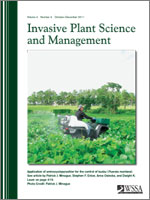Serpentine grasslands are relatively free of the invasive species that typify other California grasslands, but recently are threatened by the spread of barb goatgrass, a Eurasian annual that is unique in its tolerance of serpentine soils. We evaluated two graminicides (clethodim and fluazifop), one broad-spectrum herbicide (glyphosate), mowing, and hand pulling for their effectiveness in controlling barb goatgrass and for restoring native species cover and diversity. We also evaluated application timing for the graminicides: before goatgrass flowering (early season), at flower initiation (midseason), and at early seed development (late season). Glyphosate was applied at early seed development. The 10 treatment combinations were applied to 10 blocks of 4-m2 (43-ft2) experimental plots in an inner Coast Range serpentine grassland with high cover of barb goatgrass but few other nonnative species. After 2 yr of treatment, all treatments except glyphosate reduced goatgrass frequency. Hand pulling, fluazifop, and mowing were most effective at controlling goatgrass, reducing frequency by 60, 51, and 48%, respectively (compared to a 30% increase on control plots). Midseason applications of clethodim and fluazifop were more effective than those applied early or late. Hand pulling, fluazifop, and clethodim increased native forb frequency by 31, 46, and 74%, respectively, with the benefit of the graminicides decreasing with later applications. Native grasses were at least partially resistant to the graminicides. Cover of one sided blue grass (Poa secunda), the most widespread native grass, might have been reduced slightly by early-season applications but was increased by late-season applications. Cover of soft brome (Bromus hordeaceus), the only other widespread nonnative species in the study, was reduced by early-season applications of the graminicides. Clethodim and fluazifop show great potential to selectively remove barb goatgrass and other nonnative annual grasses in grasslands that are otherwise dominated by native grasses and forbs. Mowing is a less selective, but viable alternative.
Nomenclature: Clethodim; fluazifop; glyphosate; barb goatgrass, Aegilops triuncialis L.; Sandburg bluegrass, Poa secunda J. Presl.
Interpretive Summary: Few studies have addressed the management of barb goatgrass, which is a recent and aggressive invader of serpentine grasslands in California. In nonserpentine grasslands, 2 successive yr of prescribed fire can control barb goatgrass, but the slow fuel build up in serpentine grasslands generally prevents a complete burn in the second year. As a potential alternative or follow up to fire, we evaluated two graminicides (clethodim and fluazifop), one broad-spectrum herbicide (glyphosate), mowing, and hand pulling for their effectiveness in controlling barb goatgrass and restoring diversity and cover of native species. We also evaluated application timing for the graminicides: before barb goatgrass flowering (early season), at flower initiation (midseason), and at early seed development (late season). Glyphosate was applied at early seed development and mowing occurred at flowering. Hand pulling, which is impractical at a large scale, was included purely as a reference for the most selective possible control. All treatments except glyphosate reduced the frequency of barb goatgrass, but the best control (besides hand pulling) was provided by fluazifop and mowing. Clethodim and fluazifop are most effective when applied midseason. Clethodim provides poor control early-season, but adequate control midseason. Application of graminicides early in the season provides the most benefit to native forbs (probably because of their early release from competition), but can reduce populations of native grasses, which benefit more from applications later in the season when





